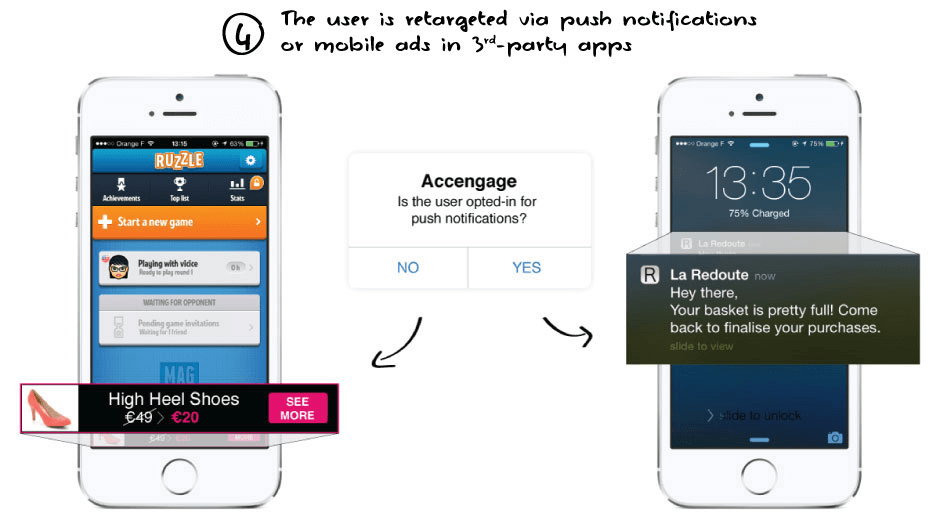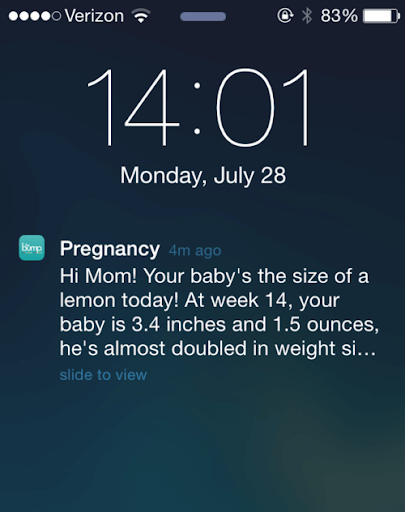Push notifications might seem like an intrusive way to catch users’ attention – so marketers are often hesitant whether implementing them makes sense. According to statistics, it does – 90% of users who got a push-notification will open it. 50% of website or app visitors don’t mind notifications at all, as long as they offer valuable information.
How can marketing teams make the most out of push notifications, newsletters, and welcome message campaigns? What are the benefits and challenges of multi-channel marketing? Today we will be answering these and other questions.
What Are Push Notifications?
That pop-up tab from Skype, Slack, or Messenger you see on your smartphone a computer whenever someone calls or text is a push-notification. By definition, it’s a message your users can read even if they are not using the website or the app at the moment.
Since push-notifications are popular lately, marketers created push notifications strategy to increase engagement and conversions.
- Informative push notifications. These let app users know when it’s time to install the latest update, remind them of a booking or an upcoming trip, and let people know when other users engaged with their accounts (e.g. an alert Instagram sends when someone double-taps your picture).
- Localized push-notifications. These messages get triggered whenever an app user in the area that matches the content of the notification. For example, if you are travelling abroad, Google Maps might send a push notification recommending to check out the most popular places at the new location.
- Re-engagement notifications. These messages help marketing managers get in touch with users who haven’t visited the app for a while. Most commonly, these are the “We haven’t seen you in a long time” messages that encourage you to either open and keep using the app or delete it for good.
- Promotional push-notifications. Sellers use these notifications to let shoppers know about lucrative offers, sales, or giveaway contests.
- Customer support push-notifications. These messages encourage app users or customers to fill in surveys and rate the quality of the product/service. Later, marketing and product development teams will use the data for references when tweaking communication strategies, product design, or creating new offers.
5 Benefits of Using Push Notifications
Getting users to open and engage with mobile apps is not easy since opening an app window takes more time than switching between browser tabs. However, push-notifications make catching people’s attention times easier. Following the best practices of web push, you can increase user engagement.
Here’s why push-notifications are an essential promotion strategy for Starbucks, Google, and other top-notch companies.
1. Improve conversion rates

If a customer is hesitant about making a buying decision, push-notifications and emails are a way to encourage him to make up his mind. One of the most prominent push notification use cases is La Redoute, a leading fashion brand, encouraging users to check out using in-browser notifications. By using push-notification and regular transactional email delivery, the company managed to deal with the abandoned cart issue, improved customer lifetime value, and increased click-through rates by three times.
2. Personalize customer interactions
Among other things, marketers love push-notifications because they help connect with app users on a deeper, personal level. Ticketmaster, for one, took advantage of geo-localized push-notifications to let band and sport team fans know when their idols and favourite athletes are participating in a nearby event.
Personalizing customer interactions has changed things drastically, increasing both ticket sales and event attendance.
3. Keep engagement constant
Unlike emails or social media, push-notifications can guide users step-by-step through the milestone of their customer journeys. Other than that, there are apps that turned push-notifications into a competitive advantage – such as The Bump.

This tool for first-time mothers uses notifications to help women track the baby’s development, don’t forget about feeding time, and stay cool-headed when overcoming the struggles of motherhood.
Netflix, too, lets users know about new releases that match their profiles using push notifications – this way, the platform keeps user engagement sky-high.
4. Improve brand recognition
Push-notifications are a low-commitment way to help people tell your company apart from its competitors. Little details like using the brand name and the logo can make a huge difference in brand awareness.
When looking for a type of product you offer and seeing your company in stores or online, a shopper will consider choosing your products simply because the name or the logo looks familiar – all thanks to seeing them regularly via newsletter, transactional emails, and push notifications.
5. Offer insights on user behaviour
One of the reasons marketers struggle to connect with users is that they don’t know the people they are reaching out to. When appealing to large audiences, it’s hard to keep track of users’ interests, in-app behaviour habits, and other relevant metrics. Push-notifications are a helpful tool for marketers in getting to know their audiences much better.
Here’s a glimpse of the marketing metrics these notifications help capture:
- The time when users feel most comfortable interacting with the app
- Devices and operating systems people use to view push notifications.
- Content and writing style of the messages that resulted in the highest engagement.
- The messages that led to the highest number of app uninstalls.
With push-notifications, you are no longer handling marketing in blind – instead, you have enough big-picture data to fuel every decision you make.
5 Best Multichannel Marketing Practices
Let’s face it: push notifications and emails are a double-edged sword. On the one hand, they help marketers connect with the app, website users, and prospective clients.
On the flip side, they are often seen as annoying and intrusive, and, if worse comes to worst, could be a reason for people to delete your app altogether.
How to make sure you make the most out of push notifications and not fall into intrusion pitfalls? Although there’s no tried-and-true answer, here are the tips that will help you stay in touch with app users without invading their privacy.
1. Choose the right time
Just like in real-life relationships, in marketing, timing is everything. Calling a friend past 12 AM hoping he will be there for you is unreasonable – so is sending push-notifications when people don’t see or care about them.
How to know that the timing for a marketing campaign is right? Use statistics for decision-making:
- 7-10 AM is the best time to send push-notifications.
- 6-10 PM is a viable option as well. Although not as efficient, it plays on our habit of checking our phones when coming back from work.
- Sending emails between 11 PM and 5 AM is an absolute no-go for marketers – your messages’ readability will be next to zero.
2. Deliver value
To make sure your push notifications make using the app or tracking your business’ updates easier for end-users instead of annoying them, create a concise, actionable copy for push-notifications. Don’t forget to add a touch of personal connection either – personalization makes a difference.

For starters, use these tips to make push-notifications and emails more value-driven:
- Create them with a goal in mind – each message you send to a user should help him complete a specific action or reach a defined goal.
- Use imperative statements to help users navigate your app/website. For example, choose “Check out my offer” instead of “Our company has launched a new offer for our users to check out”.
- Use first-person pronouns – non-formal notifications are much easier and more enjoyable to read. Also, using “I” instead of “we” puts you and your users on the same, human-to-human level of interaction.
- Keep push-notifications short: 20-90 characters is the ideal length of a push-notification message.
3. Strategize and test
It’s common for business owners to not take marketing activities seriously.
In my experience, having an understanding of which objective a campaign should achieve makes a huge difference. Similarly to other marketing campaigns, launching newsletters or push notifications should have a set marketing strategy:
- Creating a sales funnel that includes all notifications and emails an app user or a website visitor will get after completing specific actions.
- A/B-test copy and visuals. There’s no definite say whether rich or text-based notifications perform better – you need to know it for yourself. The same applies to copy – it takes trial and error to create the style users resonate with.
- Keep a careful eye on reports. Tracking open rates, conversions, and app engagement that followed each push notification will help you pinpoint your mistakes and best practices, get rid of the former, and leverage the latter. There is plenty of marketing management and productivity tools – after some research, you’ll definitely create an ultimate campaign management toolset.
4. Segment push notifications
Not all in-app notifications are equally important to users. While some carry no direct value, other than presenting a potential opportunity (finding out about new offers, leaving a product review, etc), others are crucial to your user’s efficiency. Think about Messenger or Slack notifications – without getting these, we would get in massive work-related messes.
As a business owner or a marketing manager, you should objectively assess the value and importance of different push notification types and track their efficiency separately. You should have different schedules for urgent and non-urgent push notifications as well.
Conclusion
If you still think that push notifications are nothing but an annoying trend that makes you want to delete some of your favourite apps, it’s time to reconsider this opinion. Top-notch company marketers learn to harness the potential of push-notifications in powerful ways, improving user experiences, engagement, and maximizing conversions. The efficiency of your push-notification campaign depends on how mindful of this marketing campaign and committed to it you are.
By taking your time to write concise, compelling copy, testing push notifications and monitoring their performance, you’ll take no time to find efficient ways to connect with app users.